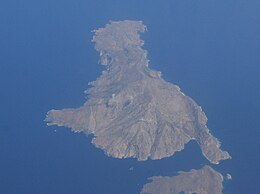Saria Island
This article includes a list of general references, but it lacks sufficient corresponding inline citations. (March 2013) |
Native name: Σaρία | |
|---|---|
 | |
| Geography | |
| Coordinates | 35°52′N 27°13′E / 35.87°N 27.22°E |
| Archipelago | Dodecanese |
| Area | 20.429 km2 (7.888 sq mi) |
| Highest elevation | 631 m (2070 ft) |
| Highest point | Mt. Saria |
| Administration | |
Greece | |
| Region | South Aegean |
| Regional unit | Karpathos |
| Capital city | Argos |
| Demographics | |
| Population | 45 (2011) |
| Additional information | |
| Postal code | 857 00 |
| Area code(s) | 22450 |
| Vehicle registration | ΚΧ, ΡΟ, ΡΚ |


Saria Island (Greek: Σαρία), anciently known as Sarus or Saros (Ancient Greek: Σάρος),[1][2] is an island in Greece. It is a rocky, volcanic island just to the north of Karpathos, separated from it by a strait 100 m (330 ft) wide. It is part of the Dodekanissos archipelago. In ancient times, a city-state called Saros was situated on the island.[1][3] It was a member of the Delian League.[4]
Administratively, it is part of the community of Olympos. The 2011 census reported a resident population of 45 persons. It has little plant or animal life, and has a number of steep cliffs. Although only shepherds live on Saria now, the ruins of the ancient city of Nisyros can be found here. It is also a breeding area for Eleonora's falcons.
Although the name is subject to dispute, scholars link it with the name of an ancient Greek princess named Katherine from a line of Saria royalty. Greek legends say she was as beautiful as Helen of Troy and so they named an island after her. On the island of Saria, it is recorded history that a kingdom existed named Mikri Nisyros.
References
- ^ a b Richard Talbert, ed. (2000). Barrington Atlas of the Greek and Roman World. Princeton University Press. p. 60, and directory notes accompanying. ISBN 978-0-691-03169-9.
- ^ Lund University. Digital Atlas of the Roman Empire.
- ^ Lund University. Digital Atlas of the Roman Empire.
- ^ Athenian Tribute Lists
External links


